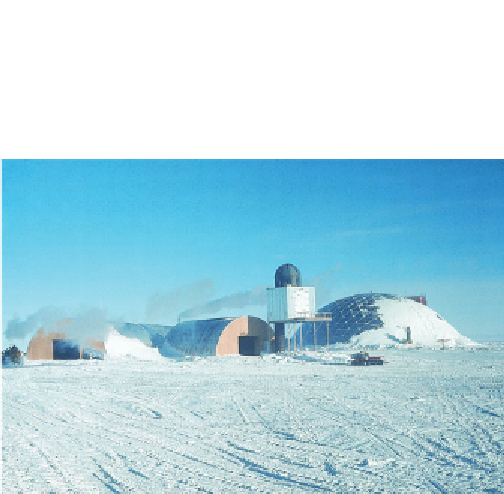Geoscience Reference
In-Depth Information
Figure 8.3
South Pole Station after
rebuilding in 1975 with a geodesic
dome. (Credit: AntarcticaNewZealand)
The north platform provides year-round accommodation, which is supplemented
by summer living space in the south platform (capacity is 16 in the winter and
52 in the summer) that also houses the science facilities. The central module is
designed for socialising and recreation and contains a dining room, gym, pool,
sauna, hydrotherapy bath, a double-height climbing wall and facilities for music and
arts and crafts. It also has panels that change colour in the winter to mimic the
changing light in a temperate climate.
Construction of the buildings at the permanent stations was originally purely
functional
they were designed to provide protection from the elements and a
place to work, sleep and eat. There was no concern for the interior comforts of the
buildings
-
after all they were meant to house explorers! Sadly, little concern was
also paid to the long-term environmental implications of human presence on the
continent. It is hard to imagine now, but 50 years ago, the snow and ice-free
areas of Adélie penguin colonies seemed like perfect places to build research
stations. Thankfully, a lot has changed. In 1991, the Protocol on Environmental
Protection was added to the Antarctic Treaty and since then the focus of designing
stations
-
-
and the activities at these
-
has shifted to one which has minimum
impact on the environment.
The high costs of building and maintaining stations in Antarctica might have
been expected to encourage the development of international shared facilities.
Whilst many stations support visiting scientists from other countries only two could
be described as international
Concordia run jointly by France and Italy, and
Jubany, an Argentine station with a major German biological laboratory attached to
it. One country, the Netherlands, has decided not to build a station but to rent space
and facilities from countries that have spare capacity
-
-
a more ef
cient use of
resources and another way of minimising impacts.



Search WWH ::

Custom Search